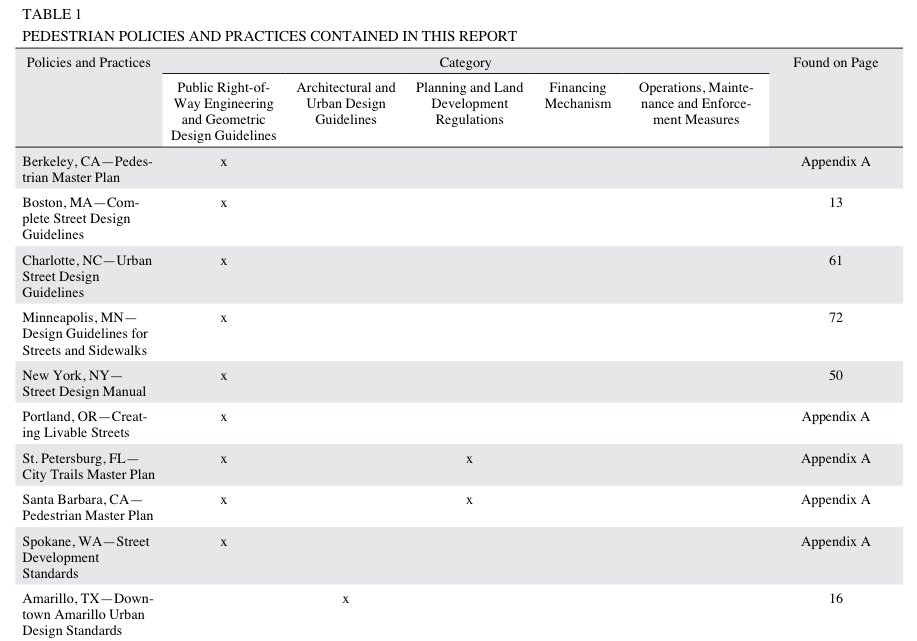NATIONAL COOPERATIVE HIGHWAY RESEARCH PROGRAM
Summary
Many communities are encouraging pedestrian transportation to improve public health and safety, reduce the public costs of private automobile travel, improve personal mobility, and create other economic benefits. Communities that have been most successful at providing pedestrian transportation options recognize that a safe and usable pedestrian environment requires more than meeting minimum standards. High-quality pedestrian environments are places where pedestrians are anticipated, encouraged, and will congregate. These communities have adopted new policies, ordinances, and guidelines to support land development patterns and streets that serve multiple transportation modes.
Creating attractive and safe pedestrian environments is often made more difficult by existing conditions created with little regard for pedestrian activity, as the second half of the 20th century was marked by the increased dominance of the automobile. Policies and practices focused on vehicle throughput—moving more vehicles through the system faster—often to the detriment of those who walk.
The objective of this synthesis is to document the regulatory, administrative, and financial tools used by communities to provide safe pedestrian environments. This report captures tools and strategies reported as effective in a range of contexts (e.g., geography, community size, weather, demographics, and regulatory requirements) and development conditions. Development conditions addressed include new and infill development, street reconstruction, and retrofitting.
It is important to note that transportation planning is not conducted in a vacuum and that the needs of pedestrians must be considered in the broader context of a transportation system that has many goals and responsibilities. This synthesis does not address the real-world complexities and trade-offs of balancing the needs of pedestrians with other modes, including automobiles, transit, freight, and bicycles. It should also be noted that while this synthesis documents practices undertaken by local governments to increase pedestrian safety and mobility, there are few objective data to support that the practices documented did improve pedestrian safety. And finally, this synthesis is not intended to offer recommendations or guidance on the selection of specific pedestrian safety measures.
The research approach for this synthesis featured two primary components: a literature review and telephone and in-person interviews with key staff in local agencies that have implemented practices designed to support pedestrian-friendly environments. This synthesis includes a state-of-the-practice overview of practices undertaken throughout the country in various settings.
Practices are presented in brief narratives that provide vignettes of their development and implementation and the players involved. Four case studies (New York City, New York; Charlotte, North Carolina; Minneapolis, Minnesota; and Olympia, Washington) are presented to offer a detailed exploration of communities that have implemented various practices and how those practices are coordinated and interact.
The practices presented in this synthesis are categorized by (1) public right-of-way engineering and design guidelines; (2) architectural and urban design guidelines; (3) planning and land development regulations; (4) financing mechanisms; and (5) operations, maintenance, and enforcement measures. They represent diverse geographic and demographic conditions, and have applications for a range of development contexts including new and infill development, street reconstruction, and retrofit conditions. It should be noted that information pertaining to policies and practices implemented in rural communities (defined as communities of less than 5,000 residents and regions less than 50,000 residents) was difficult to gather. Policies and practices to support safe pedestrian environments in rural settings emerged as a future research need.
The synthesis finds the following:
• Support from high-ranking agency leaders and elected officials is often an important component of success. This support provides staff with guidance on priorities and can induce crucial cooperation and collaboration between agencies at different levels of government.
• Formal policy guidance also serves an important role. This guidance is delivered in comprehensive plans, action plans, policy statements, or other documents that provide departments and their staff with clear policy direction. Practices included in this synthesis were frequently developed under the direction of these guiding documents, which in some cases represented significant shifts in policy. Shifts in policy can be difficult to institutionalize, though, and formal policy guidance with the support of agency leadership can facilitate this change.
• Interagency cooperation can be critical. The pedestrian environment is composed of elements that are the purview of a wide range of fields and may fall under the jurisdiction of multiple administrative levels. Practices that support the creation of safe pedestrian environments often rely on the expertise, cooperation, and meaningful collaboration of diverse agencies. Barriers can arise when these agencies do not share philosophical perspectives on the role and value of pedestrians.
• Community outreach also demonstrates significant benefit for these practices. Some of the practices included in this synthesis are based on community-driven processes, while others require public input and consent. Often, public opposition to these practices was assuaged or avoided through meaningful outreach and participatory processes.
Download full report (PDF): Local Policies and Practices That Support Safe Pedestrian Environments
About the National Cooperative Highway Research Program
www.trb.org/NCHRP/
“The National Cooperative Highway Research Program (NCHRP) conducts research in problem areas that affect highway planning, design, construction, operation, and maintenance nationwide.”







 RSS Feed
RSS Feed